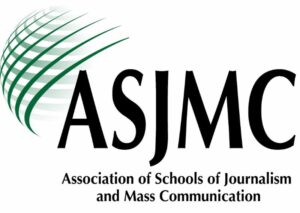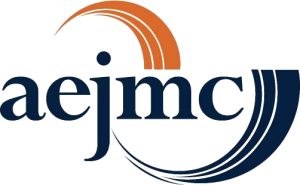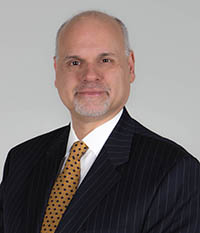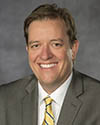CONTACT: James Stewart, Nicholls State University, 2019-20 ASJMC President and David Perlmutter, Texas Tech University, 2019-20 AEJMC President | June 9, 2020
Association of Schools of Journalism and Mass Communication (ASJMC)
and Association for Education in Journalism and Mass Communication (AEJMC)
“Justice will not be served until those who are unaffected are as
outraged as those who are.” — Benjamin Franklin
We the Boards of Directors of the Association of Schools of Journalism and Mass Communication (ASJMC) and the Association for Education in Journalism and Mass Communication (AEJMC) present this joint statement to condemn arrests and violence toward journalists covering widespread citizen protests for racial justice.
The protests and demonstrations across the U.S. are meant to call attention to the brutal treatment that communities of color, especially Black Americans, endure. The majority of these demonstrations are peaceful; however, there have been numerous instances where citizens have been injured in clashes with police wielding batons, rubber bullets and tear gas in their efforts to dismantle crowds.
Among the injured and arrested this time are working journalists, predominantly Black journalists such as CNN’s Omar Jimenez, and later his colleagues Bill Kirkos and Leone Mendez while working in Minneapolis; Branden Hunter at the Detroit Free Press; and Tyler Blint-Welsh at the Wall Street Journal, all of whom were detained while reporting from the field. News photographer Linda Tirado was shot in the face with a rubber bullet while photographing protests in Minneapolis; doctors have determined that she is blind in her left eye as a result.
One of the canons of the U.S. Constitution is the First Amendment, which guarantees freedom of the press and the right to assembly. These are bedrocks of Americans’ freedoms. When the Kerner Commission Report was released in 1968, it pointed to the need for more minorities working in newsrooms to provide accurate and sensitive coverage of people of color and their communities. More than 50 years later, we see targeted arrests of journalists of color who seek through reporting to provide inclusion and perspective for all communities, and do so at great peril.
Journalists in Minneapolis, Washington, D.C., Chicago, Houston, and other communities are there to bear witness; they are there to capture and report the voices, sights and sounds of individuals who are not just protesting, but want people to listen to their reality. Listen to the pain and loss caused by the violent murders of George Floyd, Breonna Taylor and Ahmaud Arbery, and so many more Black lives taken by police brutality and misconduct.
America must address its societal issues from racism and discrimination, to #MeToo, LGBTQ+, immigration, the haves and have nots, the COVID-19 pandemic, and, of course, the political partisanship across the nation that has fueled national division. Journalists must be able to report freely if we have any hope of understanding and addressing the issues that ail our nation. Journalists should not face arrest and physical injury for doing their jobs. As journalism educators, we oppose violence of any type, particularly against working journalists who are covering the important stories as they happen.
Journalists are our watchdogs; when news reporting is carried out with professionalism, keen insight and inclusion, it doggedly seeks to capture all voices. Those in higher education who prepare journalists to undertake professional work support and encourage journalists of all hues to look for the underlying story to give context to people’s lives and communities.
ASJMC and AEJMC are here to spotlight that moment where preparation (education and training) meets application – no greater example exists right now than the protests spreading across the nation. The vast majority of academics in communication and journalism schools are former journalists and media professionals, with many still in practice. The work of journalists matters in capturing history as it unfolds. Higher education challenges and prepares journalists to do this well. Whether by pen and paper, camera or cell phone, legacy media or new media, when history unfolds the Fourth Estate is there to tell the story. ASJMC and AEJMC unequivocally support this First Amendment right, and we stand in support of journalists doing their work to tell the stories that need to be told.
________________________________________
Association of Schools of Journalism and Mass Communication (ASJMC)
ASJMC is a non-profit, educational association composed of some 190 JMC programs at the college level. The majority of the association’s members are in the United States and Canada. ASJMC promotes excellence in journalism and mass communication education. Founded in 1917, ASJMC works to support the purposes of schools of journalism and mass communication in order to achieve the following goals: to foster, encourage and facilitate high standards and effective practices in the process and administration of education for journalism and mass communication in institutions of higher learning; to cooperate with journalism and mass communication organizations in efforts to raise professional standards and promote a public understanding of the role of journalism and mass communication in a democratic society; and to support and participate in the accreditation process of journalism and mass communication units through the Accrediting Council on Education in Journalism and Mass Communications (ACEJMC).
Association for Education in Journalism and Mass Communication (AEJMC)
The Association for Education in Journalism and Mass Communication (AEJMC) is a nonprofit organization of more than 3,700 educators, students and practitioners from around the globe. Founded in 1912, by Willard Grosvenor Bleyer, the first president (1912-13) of the American Association of Teachers of Journalism, as it was then known, AEJMC is the oldest and largest alliance of journalism and mass communication educators and administrators at the college level. AEJMC’s mission is to promote the highest possible standards for journalism and mass communication education, to encourage the widest possible range of communication research, to encourage the implementation of a multi-cultural society in the classroom and curriculum, and to defend and maintain freedom of communication in an effort to achieve better professional practice, a better informed public, and wider human understanding.



 David D. Perlmutter, Ph.D.
David D. Perlmutter, Ph.D. By Emily T. Metzgar
By Emily T. Metzgar By Marcus Messner
By Marcus Messner